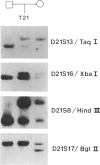Abstract
By combining molecular and cytogenetic techniques, we demonstrated the feasibility and desirability of a comprehensive approach to analysis of nondisjunction for chromosome 21. We analyzed the parental origin and stage of meiotic errors resulting in trisomy 21 in each of five families by successfully using cytogenetic heteromorphisms and DNA polymorphisms. The 16 DNA fragments used to detect polymorphisms spanned the length of the long arm and detected recombinational events on nondisjoined chromosomes in both maternal meiosis I and maternal meiosis II errors. The meiotic stage at which errors occurred was determined by sandwiching the centromere between cytogenetic heteromorphisms on 21p and an informative haplotype constructed using two polymorphic DNA probes that map to 21q just below the centromere. This study illustrates the necessity of combining cytogenetic polymorphisms on 21p with DNA polymorphisms spanning 21q to determine (1) the source and stage of meiotic errors that lead to trisomy 21 and (2) whether an association exists between nondisjunction and meiotic recombination.
Full text
PDF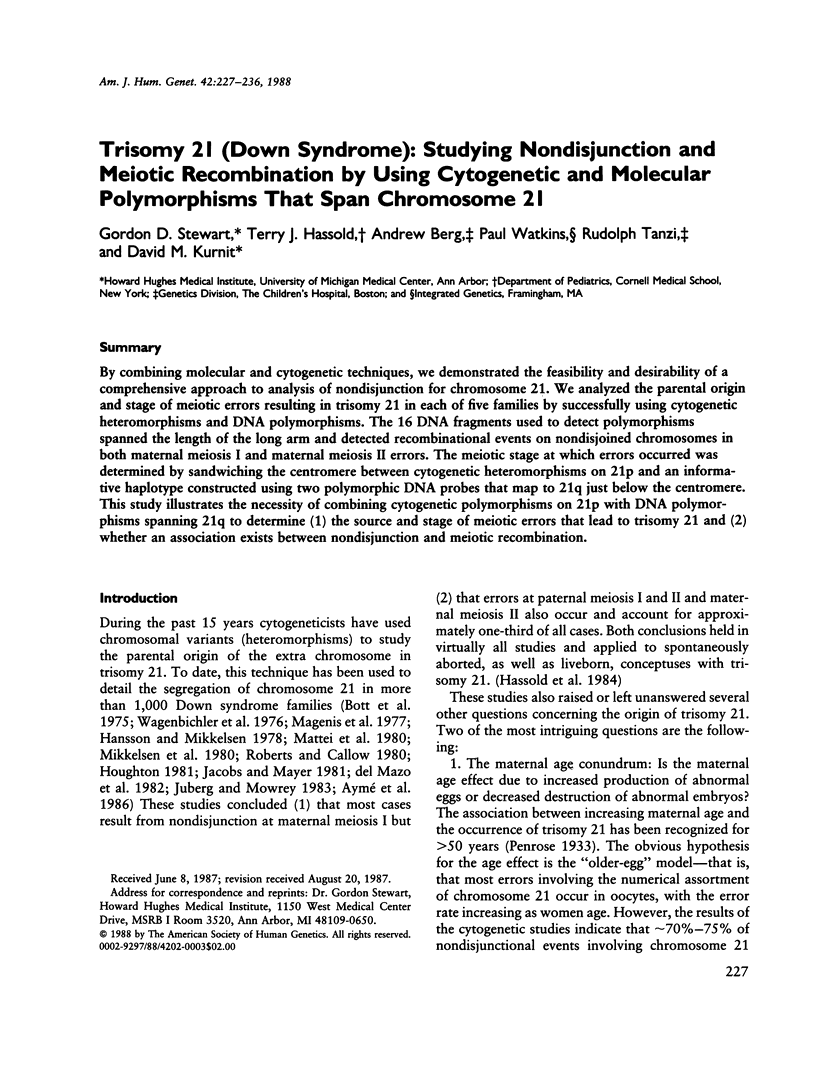
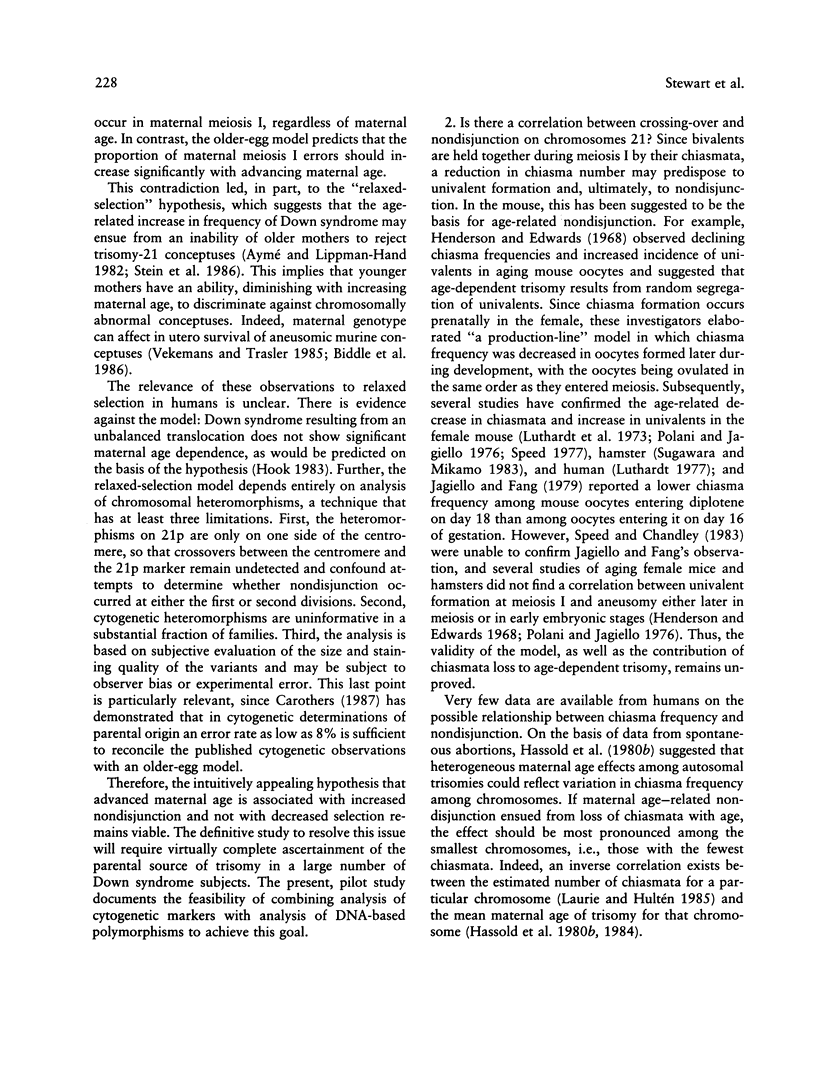
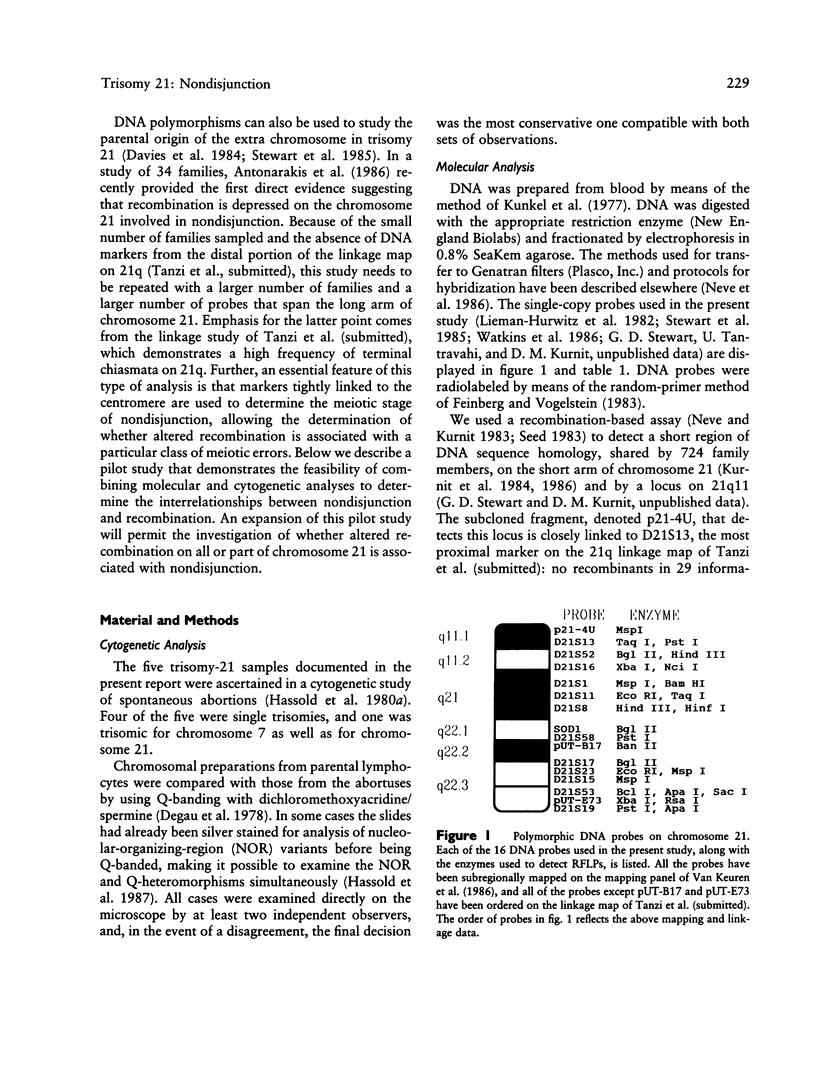
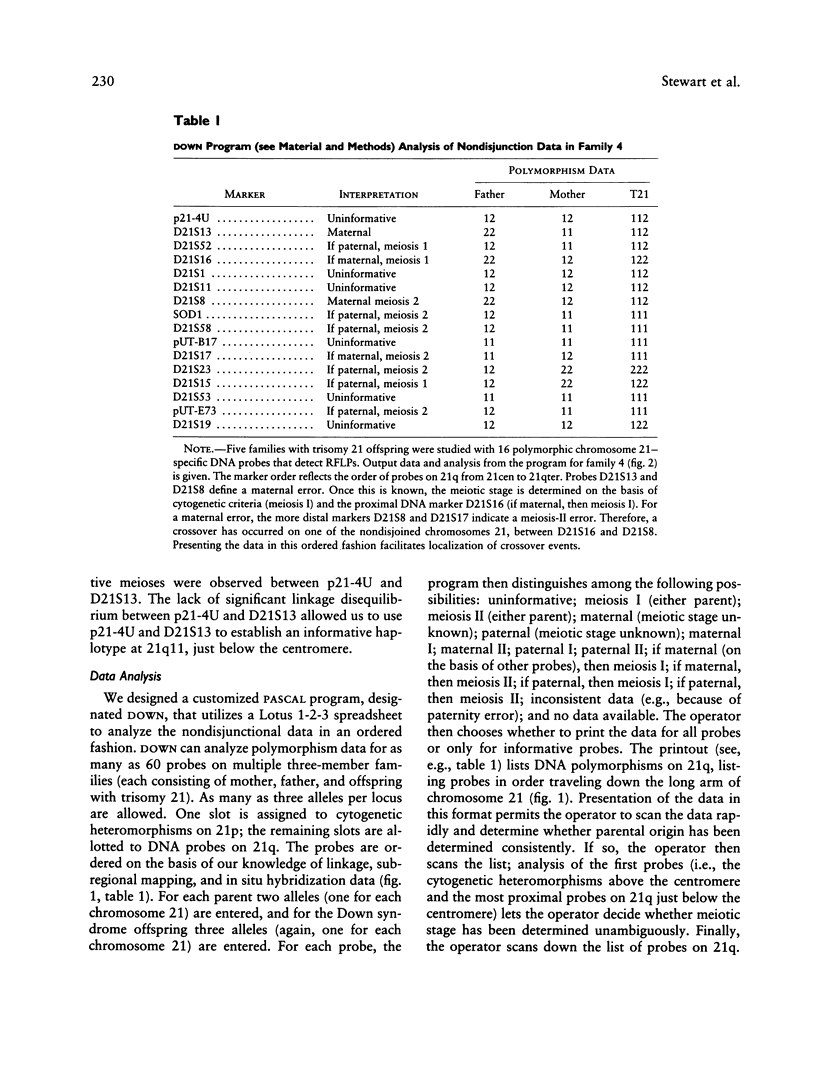


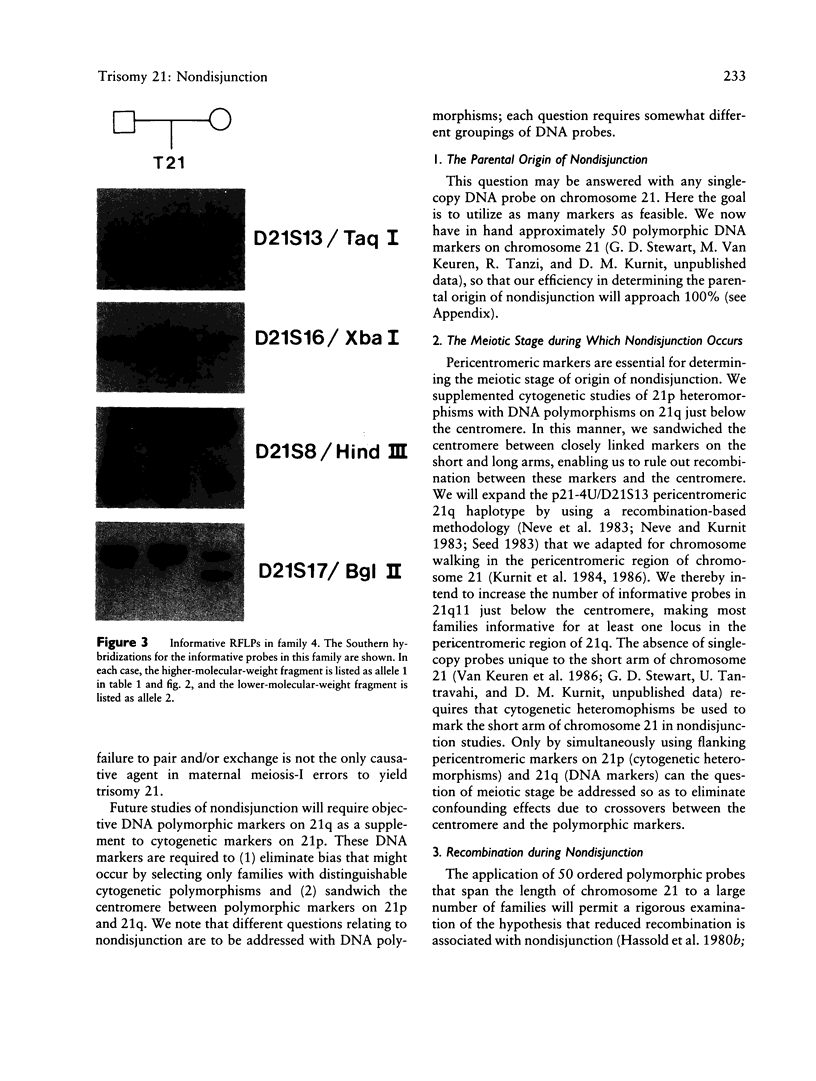

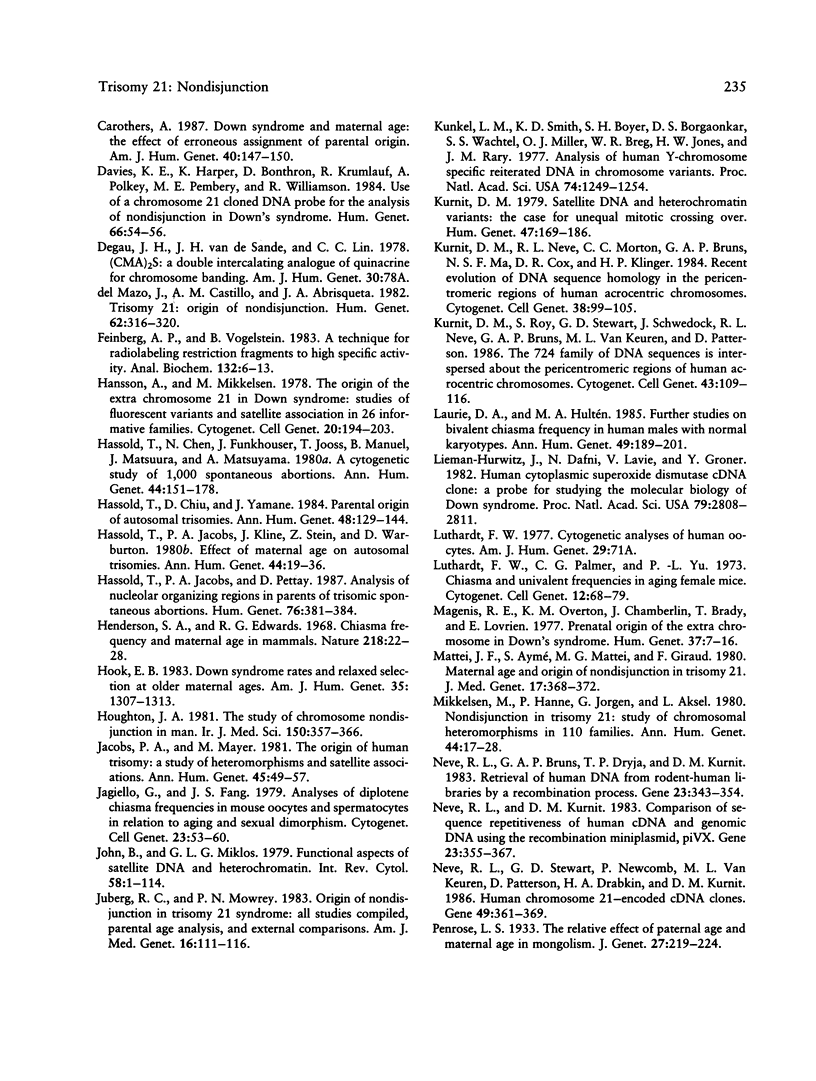
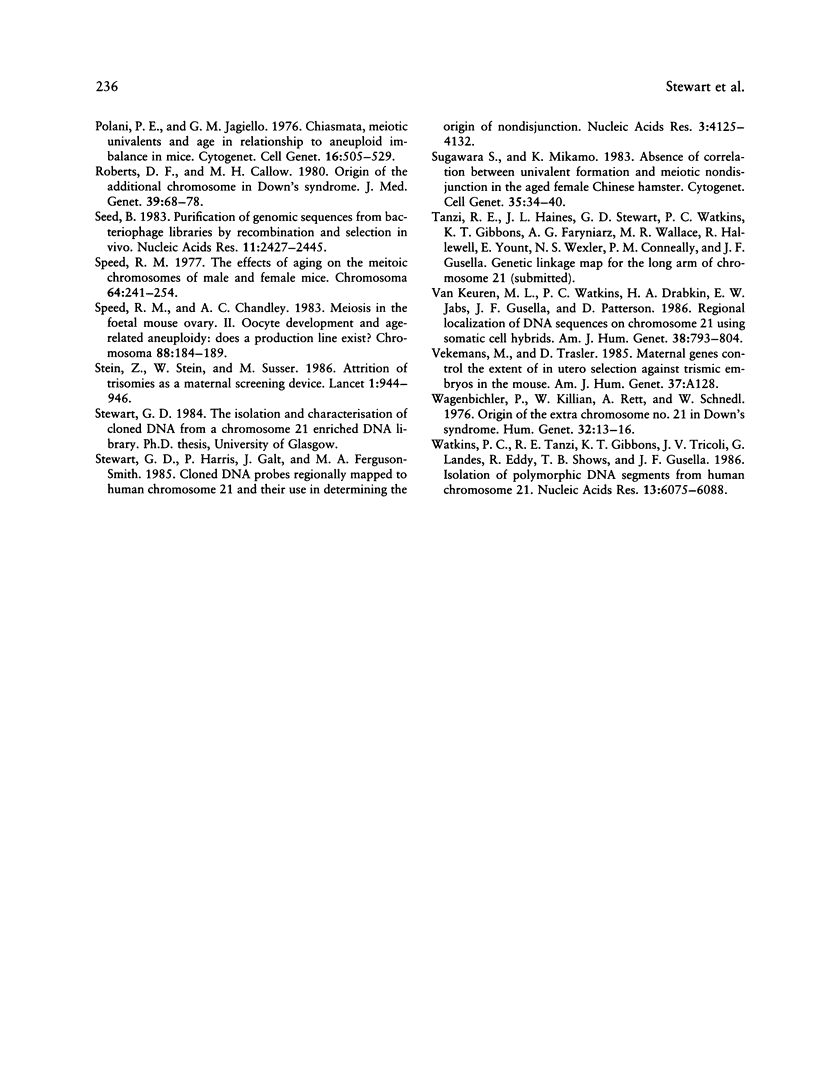
Images in this article
Selected References
These references are in PubMed. This may not be the complete list of references from this article.
- Alvesalo L., de la Chapelle A. Tooth sizes in two males with deletions of the long arm of the Y-chromosome. Ann Hum Genet. 1981 Feb;45(Pt 1):49–54. doi: 10.1111/j.1469-1809.1981.tb00305.x. [DOI] [PubMed] [Google Scholar]
- Antonarakis S. E., Chakravarti A., Warren A. C., Slaugenhaupt S. A., Wong C., Halloran S. L., Metaxotou C. Reduced recombination rate on chromosomes 21 that have undergone nondisjunction. Cold Spring Harb Symp Quant Biol. 1986;51(Pt 1):185–190. doi: 10.1101/sqb.1986.051.01.022. [DOI] [PubMed] [Google Scholar]
- Aymé S., Lippman-Hand A. Maternal-age effect in aneuploidy: does altered embryonic selection play a role? Am J Hum Genet. 1982 Jul;34(4):558–565. [PMC free article] [PubMed] [Google Scholar]
- Carothers A. D. Down syndrome and maternal age: the effect of erroneous assignment of parental origin. Am J Hum Genet. 1987 Feb;40(2):147–150. [PMC free article] [PubMed] [Google Scholar]
- Davies K. E., Harper K., Bonthron D., Krumlauf R., Polkey A., Pembrey M. E., Williamson R. Use of a chromosome 21 cloned DNA probe for the analysis of non-disjunction in Down syndrome. Hum Genet. 1984;66(1):54–56. doi: 10.1007/BF00275186. [DOI] [PubMed] [Google Scholar]
- Feinberg A. P., Vogelstein B. A technique for radiolabeling DNA restriction endonuclease fragments to high specific activity. Anal Biochem. 1983 Jul 1;132(1):6–13. doi: 10.1016/0003-2697(83)90418-9. [DOI] [PubMed] [Google Scholar]
- Hansson A., Mikkelsen M. The origin of the extra chromosome 21 in Down syndrome. Studies of fluorescent variants and satelite association in 26 informative families. Cytogenet Cell Genet. 1978;20(1-6):194–203. doi: 10.1159/000130851. [DOI] [PubMed] [Google Scholar]
- Hassold T., Chen N., Funkhouser J., Jooss T., Manuel B., Matsuura J., Matsuyama A., Wilson C., Yamane J. A., Jacobs P. A. A cytogenetic study of 1000 spontaneous abortions. Ann Hum Genet. 1980 Oct;44(Pt 2):151–178. doi: 10.1111/j.1469-1809.1980.tb00955.x. [DOI] [PubMed] [Google Scholar]
- Hassold T., Chiu D., Yamane J. A. Parental origin of autosomal trisomies. Ann Hum Genet. 1984 May;48(Pt 2):129–144. doi: 10.1111/j.1469-1809.1984.tb01008.x. [DOI] [PubMed] [Google Scholar]
- Hassold T., Jacobs P. A., Pettay D. Analysis of nucleolar organizing regions in parents of trisomic spontaneous abortions. Hum Genet. 1987 Aug;76(4):381–384. doi: 10.1007/BF00272449. [DOI] [PubMed] [Google Scholar]
- Hassold T., Jacobs P., Kline J., Stein Z., Warburton D. Effect of maternal age on autosomal trisomies. Ann Hum Genet. 1980 Jul;44(Pt 1):29–36. doi: 10.1111/j.1469-1809.1980.tb00943.x. [DOI] [PubMed] [Google Scholar]
- Henderson S. A., Edwards R. G. Chiasma frequency and maternal age in mammals. Nature. 1968 Apr 6;218(5136):22–28. doi: 10.1038/218022a0. [DOI] [PubMed] [Google Scholar]
- Hook E. B. Down syndrome rates and relaxed selection at older maternal ages. Am J Hum Genet. 1983 Nov;35(6):1307–1313. [PMC free article] [PubMed] [Google Scholar]
- Houghton J. A. The study of chromosome non-disjunction in man. Ir J Med Sci. 1981 Dec;150(12):357–366. doi: 10.1007/BF02938274. [DOI] [PubMed] [Google Scholar]
- Jagiello G., Fang J. S. Analyses of diplotene chiasma frequencies in mouse oocytes and spermatocytes in relation to ageing and sexual dimorphism. Cytogenet Cell Genet. 1979;23(1-2):53–60. doi: 10.1159/000131302. [DOI] [PubMed] [Google Scholar]
- John B., Miklos G. L. Functional aspects of satellite DNA and heterochromatin. Int Rev Cytol. 1979;58:1–114. doi: 10.1016/s0074-7696(08)61473-4. [DOI] [PubMed] [Google Scholar]
- Juberg R. C., Mowrey P. N. Origin of nondisjunction in trisomy 21 syndrome: all studies compiled, parental age analysis, and international comparisons. Am J Med Genet. 1983 Sep;16(1):111–116. doi: 10.1002/ajmg.1320160117. [DOI] [PubMed] [Google Scholar]
- Kunkel L. M., Smith K. D., Boyer S. H., Borgaonkar D. S., Wachtel S. S., Miller O. J., Breg W. R., Jones H. W., Jr, Rary J. M. Analysis of human Y-chromosome-specific reiterated DNA in chromosome variants. Proc Natl Acad Sci U S A. 1977 Mar;74(3):1245–1249. doi: 10.1073/pnas.74.3.1245. [DOI] [PMC free article] [PubMed] [Google Scholar]
- Kurnit D. M., Neve R. L., Morton C. C., Bruns G. A., Ma N. S., Cox D. R., Klinger H. P. Recent evolution of DNA sequence homology in the pericentromeric regions of human acrocentric chromosomes. Cytogenet Cell Genet. 1984;38(2):99–105. doi: 10.1159/000132039. [DOI] [PubMed] [Google Scholar]
- Kurnit D. M., Roy S., Stewart G. D., Schwedock J., Neve R. L., Bruns G. A., Van Keuren M. L., Patterson D. The 724 family of DNA sequences is interspersed about the pericentromeric regions of human acrocentric chromosomes. Cytogenet Cell Genet. 1986;43(1-2):109–116. doi: 10.1159/000132305. [DOI] [PubMed] [Google Scholar]
- Kurnit D. M. Satellite DNA and heterochromatin variants: the case for unequal mitotic crossing over. Hum Genet. 1979 Mar 12;47(2):169–186. doi: 10.1007/BF00273199. [DOI] [PubMed] [Google Scholar]
- Laurie D. A., Hultén M. A. Further studies on bivalent chiasma frequency in human males with normal karyotypes. Ann Hum Genet. 1985 Jul;49(Pt 3):189–201. doi: 10.1111/j.1469-1809.1985.tb01693.x. [DOI] [PubMed] [Google Scholar]
- Lieman-Hurwitz J., Dafni N., Lavie V., Groner Y. Human cytoplasmic superoxide dismutase cDNA clone: a probe for studying the molecular biology of Down syndrome. Proc Natl Acad Sci U S A. 1982 May;79(9):2808–2811. doi: 10.1073/pnas.79.9.2808. [DOI] [PMC free article] [PubMed] [Google Scholar]
- Luthardt F. W., Palmer C. G., Yu P. Chiasma and univalent frequencies in aging female mice. Cytogenet Cell Genet. 1973;12(1):68–79. doi: 10.1159/000130440. [DOI] [PubMed] [Google Scholar]
- Magenis R. E., Overton K. M., Chamberlin J., Brady T., Lovrien E. Parental origin of the extra chromosome in Down's syndrome. Hum Genet. 1977 Jun 10;37(1):7–16. doi: 10.1007/BF00293766. [DOI] [PubMed] [Google Scholar]
- Mattei J. F., Ayme S., Mattei M. G., Giraud F. Maternal age and origin of non-disjunction in trisomy 21. J Med Genet. 1980 Oct;17(5):368–372. doi: 10.1136/jmg.17.5.368. [DOI] [PMC free article] [PubMed] [Google Scholar]
- Mikkelsen M., Poulsen H., Grinsted J., Lange A. Non-disjunction in trisomy 21: study of chromosomal heteromorphisms in 110 families. Ann Hum Genet. 1980 Jul;44(Pt 1):17–28. doi: 10.1111/j.1469-1809.1980.tb00942.x. [DOI] [PubMed] [Google Scholar]
- Neve R. L., Bruns G. A., Dryja T. P., Kurnit D. M. Retrieval of human DNA from rodent-human genomic libraries by a recombination process. Gene. 1983 Sep;23(3):343–354. doi: 10.1016/0378-1119(83)90023-9. [DOI] [PubMed] [Google Scholar]
- Neve R. L., Kurnit D. M. Comparison of sequence repetitiveness of human cDNA and genomic DNA using the miniplasmid vector, piVX. Gene. 1983 Sep;23(3):355–367. doi: 10.1016/0378-1119(83)90024-0. [DOI] [PubMed] [Google Scholar]
- Neve R. L., Stewart G. D., Newcomb P., Van Keuren M. L., Patterson D., Drabkin H. A., Kurnit D. M. Human chromosome 21-encoded cDNA clones. Gene. 1986;49(3):361–369. doi: 10.1016/0378-1119(86)90372-0. [DOI] [PubMed] [Google Scholar]
- Polani P. E., Jagiello G. M. Chiasmata, meiotic univalents, and age in relation to aneuploid imbalance in mice. Cytogenet Cell Genet. 1976;16(6):505–529. doi: 10.1159/000130668. [DOI] [PubMed] [Google Scholar]
- Seed B. Purification of genomic sequences from bacteriophage libraries by recombination and selection in vivo. Nucleic Acids Res. 1983 Apr 25;11(8):2427–2445. doi: 10.1093/nar/11.8.2427. [DOI] [PMC free article] [PubMed] [Google Scholar]
- Speed R. M., Chandley A. C. Meiosis in the foetal mouse ovary. II. Oocyte development and age-related aneuploidy. Does a production line exist? Chromosoma. 1983;88(3):184–189. doi: 10.1007/BF00285618. [DOI] [PubMed] [Google Scholar]
- Speed R. M. The effects of ageing on the meiotic chromosomes of male and female mice. Chromosoma. 1977 Nov 30;64(3):241–254. doi: 10.1007/BF00328080. [DOI] [PubMed] [Google Scholar]
- Stein Z., Stein W., Susser M. Attrition of trisomies as a maternal screening device. An explanation of the association of trisomy 21 with maternal age. Lancet. 1986 Apr 26;1(8487):944–947. doi: 10.1016/s0140-6736(86)91046-9. [DOI] [PubMed] [Google Scholar]
- Stewart G. D., Harris P., Galt J., Ferguson-Smith M. A. Cloned DNA probes regionally mapped to human chromosome 21 and their use in determining the origin of nondisjunction. Nucleic Acids Res. 1985 Jun 11;13(11):4125–4132. doi: 10.1093/nar/13.11.4125. [DOI] [PMC free article] [PubMed] [Google Scholar]
- Sugawara S., Mikamo K. Absence of correlation between univalent formation and meiotic nondisjunction in aged female Chinese hamsters. Cytogenet Cell Genet. 1983;35(1):34–40. doi: 10.1159/000131833. [DOI] [PubMed] [Google Scholar]
- Van Keuren M. L., Watkins P. C., Drabkin H. A., Jabs E. W., Gusella J. F., Patterson D. Regional localization of DNA sequences on chromosome 21 using somatic cell hybrids. Am J Hum Genet. 1986 Jun;38(6):793–804. [PMC free article] [PubMed] [Google Scholar]
- Wagenbichler P., Killian W., Rett A., Schnedl W. Origin of the extra chromosome no. 21 in Down's syndrome. Hum Genet. 1976 Apr 15;32(1):13–16. doi: 10.1007/BF00569971. [DOI] [PubMed] [Google Scholar]
- Watkins P. C., Tanzi R. E., Gibbons K. T., Tricoli J. V., Landes G., Eddy R., Shows T. B., Gusella J. F. Isolation of polymorphic DNA segments from human chromosome 21. Nucleic Acids Res. 1985 Sep 11;13(17):6075–6088. doi: 10.1093/nar/13.17.6075. [DOI] [PMC free article] [PubMed] [Google Scholar]
- del Mazo J., Pérez Castillo A., Abrisqueta J. A. Trisomy 21: origin of non-disjunction. Hum Genet. 1982;62(4):316–320. doi: 10.1007/BF00304546. [DOI] [PubMed] [Google Scholar]



